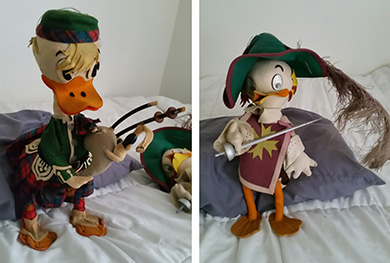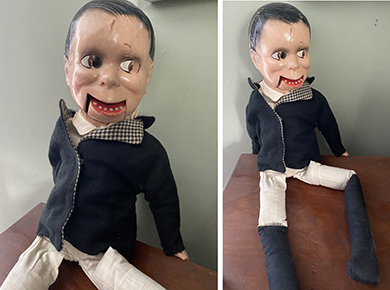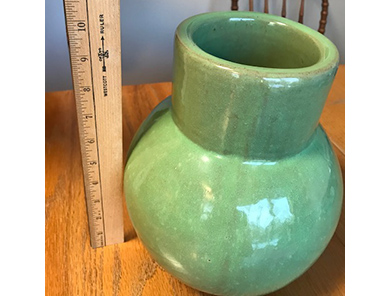 |
|
|||
 |
 |
|||
RINKER ON COLLECTIBLES — Column #1783 Copyright © Harry Rinker, LLC 2021 Questions
and Answers
QUESTION: I have two Lenci Donald Duck dolls, each with a Lenci tag. The 20” inch dolls were from Disneyland in the 1930s or 1940s. The first is Donald Duck wearing a Scottish costume and holding a bagpipe. The bagpipes need repair. The outfit has a few water stains. The second is Donald Duck dressed as one of the Three Musketeers. It needs some clearing but otherwise is in very good condition. I called the Disney archives. The staff was unable to help me. I would like to sell them. What are they worth? – TA, Email Question 
ANSWER: Your two Lenci Disney Donald Duck dolls have nothing to do with Disneyland. Disneyland, located in Anaheim, California, did not open until July 17, 1955. Lenci’s 1958 catalog included its Series 133, a collection of Disney character dolls. Sizes ranged from 15 to 20 inches in height. There were several Donald Duck dolls dressed in a variety of costumes ranging from an Alitalia airline pilot to a cowboy. Grandma Duck, Uncle Scrooge, Panchito Pistoles from the Three Caballeros, Jiminy Cricket, and the Three Little Pigs were among the other characters. A search on Worthpoint.com suggests a sell through price for a Lenci Donald Duck doll in very good condition is between $80.00 and $100.00. Larger dolls in fine or better condition realize between $150.00 and $180.00. I found no information suggesting the Lenci dolls were imported to America or sold at Disneyworld. Although a few examples made it stateside, the majority appear to have been sold in Europe. The best sales approach is a specialized doll auction house such as McMasters Harris (www.mcmastersharris.com). eBay also is a possibility. If you select this route, make certain your listing will appear on the European eBay sale sites as well as eBay.com, which is eBay’s American site. QUESTION: I have a ventriloquist dummy. When I contacted www.ventriloquistcentral.com five years ago, I heard back from Dan who told me my dummy was made by the Regal Toy Co. in Canada in the late 1930s to 1940s. It was designed to compete with the popular Charlie McCarthy ventriloquist dummy of the era. Dan informed me that in mint condition, the dummy is worth about $85.00. Was Dan telling me the truth? – CJ, CT, Email-Question 
ANSWER: The answer is no with a little yes attached. First, I found no listing for a Regal Toy Company in Canada during the 1930s. There was a Regal Toy Company located in Toronto, Canada. It was founded by Solomon Frank Samuels and his brother Ben Samuels in 1959. The company made a wide variety of hard plastic and vinyl dolls. Your ventriloquist dummy dates from the late 1930s, too early to have been issued by the Regal Toy Company of Toronto, Canada. The Regal Doll Manufacturing Company with its factory in Trenton, New Jersey, and sales offices in New York City produced composition dolls from 1919-1940. It became the Regal Doll Corporation in 1937. Prior to 1918, it was the German American Doll Company. In October 1933, The Regal Doll Manufacturing Company acquired the Horsman Doll Company and manufactured dolls under the Horsman and Regal trade names. I found no evidence that the Regal Doll Manufacturing Company produced your ventriloquist dummy. In researching your ventriloquist dummy, I found several listings on WorthPoint.com and elsewhere on the internet that attributed the dummy to the Freundlich Toy Company. Ralph A. Freundlich began his career working for the Jeanette Doll Company (1923 to 1929) before forming the Silver Doll & Toy Company in 1923. Freundlich operated out of New York City from 1929 to 1934 when he moved his manufacturing facilities to Clinton, Massachusetts. From 1934 until ceasing operations in 1945, he gained a reputation for making composition novelty dolls. All Freundlich dolls are unmarked, making them a challenge to identify. Information on “Ralph A. Freundlich Dolls 1929-1945” on www.dollreference.com [https://dollreference.com/freundlich_ralph_dolls.html] notes: “1938+ Freundlich Dummy Dan doll, 20” tall, ventriloquist doll, composition head and limbs, cloth body, painted facial features, molded painted black hair, vent doll is unmarked……Same head also used on the Davy Crocket ventriloquist doll by The Leda Company….Freundlich used the Dummy Dan head mold for a Cowboy marionette puppet and Clown marionette puppet…” Your ventriloquist dummy is known as Dummy Dan or more commonly as Dapper Dan. There are three value keys. The first is the string used to manipulate the mouth. It must be intact and workable. The second is the condition of the composition head and hands. This value also includes the condition of the paint. The third is the completeness of the doll. I was not able to determine from the pictures that accompanied your email whether or not the string was still attached and working. The head appears to have a crack in the center of the hairline but otherwise seems in very good condition. I could not see the hands to determine their condition. As to completeness, your Dapper Dan dummy is missing several key clothing parts – his checkered hat, black bowtie, shirt, and checkered pants. Assuming that the mouth control cord is present and functionable plus there are no major problems with the composition hands, you have two choices. In its present condition, your Dapper Dan dummy has a value between $10.00 and $15.00. The value of around $85.00 that Dan from Ventriloquist Central provided for a complete workable Dapper Dan with full costume is correct. Incomplete Dapper Dan dummies with composition problems, sell between $10.00 and $20.00. I found a listing for an example with all its clothing but not working and with an unrestorable face for under $15.00. For $15.00, I would buy the fully clothed doll and switch the outfit to your doll. It would increase the value of your example by two or three times Of course, if the mouth control cord is not present and/or does not work and the hands have deteriorated, sell the doll as is. QUESTION: My wife and I recently began collecting Arts & Craft pottery and assembled a collection that represents most of the major manufacturers and a few of the lesser ones. Recently, we purchased a unique piece. There are no markings on the bottom. It has a green glaze, thick clay body, and has a bottom bulbous shape with a high neck rim. The seller suggested it was from Boys Town. Could that be right? We are eager to learn your opinion. A&RW, St. Joseph, MI, Email Question 
ANSWER: The seller is not correct. After reading what follows, you may have second thoughts about asking my opinion. Every potter or pottery manufacturer, large or small, has a shape vocabulary. A shape vocabulary is established by the hand thrown shapes and molds potters use to create their wares. I spent some time researching the shape vocabulary of the Boys Town art pottery. There was no shape that remotely resembled the piece you purchased. The desire to discover a hidden treasure often clouds buying judgement, especially the judgement of beginning collectors. The lure of taking a chance that an unmarked piece is going to be a hidden gem is simply too tempting to pass up, especially when a seller does a good job convincing the buyer that such a probability exists. The shape of your piece, the color of the glaze, and the thick body suggest that the piece is floral ware—mass-produced, inexpensive pottery sold to flower shops as containers used to hold arrangements sold by the flower shop. Many of the commercial art pottery manufacturers had a floral shop line. Haeger, Red Wing, Roseville, and Weller produced utilitarian and functionable wares. The fact that these wares exhibited great design was a bonus. My advice to beginning collectors is simple – do not buy what you do not know. A few hidden treasures may slip by in the early collecting years. Money is better spent on well documented pieces than taking a chance on an unmarked piece hoping it is one thing only to find out that it is another. QUESTION: I have an Oakite metal plate in its period packaging and the instruction letter on how to use it. The plate envelope reads “A Magic Silver Cleaning Plate, a gift for you from New Oakite, the Modern Cleaner.” I am not certain what to make of it – sell, toss, or donate. What should I do? – SD, Landsdale, PA, Email Question 
ANSWER: Destroy it. Bury it deep in the earth or the landfill. The metal cleaning plate is a major threat to any plated or regular metal exposed to it. Dirt is removed from metal plating and metal by removing a thin layer of metal. The more a piece is polished, the more the plating or metal is removed. Over-cleaning often removes all the plating or lessens the design detail on a metal object. The “Magic Silver Cleaning Plate” does not gently remove the surface plating or metal. It eats away enormous amounts of the plating or surface. It would require dozens of hand polishings to duplicate the damage done by the “Magic Silver Cleaning Plate” in a matter of seconds. These plates were all the rage in the 1950s and 1960s and occasionally reappear from time to time. It seems each generation has to learn the damage they cause through firsthand experience. I have a collection of objects I entitled the Industrial Hall of Shame. If I owned an example of this plate in its period packaging, it would be a star in the collection. Harry L. Rinker welcomes questions from readers about
collectibles, those mass-produced items from the twentieth and twenty-first centuries.
Selected letters will be answered in this column.
Harry cannot provide personal answers.
Photos and other material submitted cannot be
returned.
Send your questions to: Rinker on Collectibles, 5955 Mill
Point Court SE, Kentwood, MI 49512.
You also can e-mail your questions to
harrylrinker@aol.com.
Only e-mails containing a full name and mailing address
will be considered.
|
||||